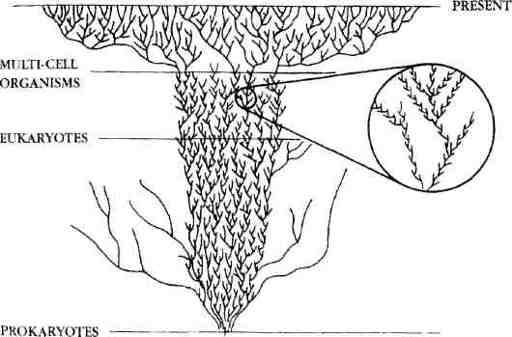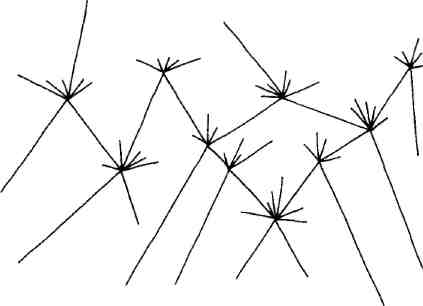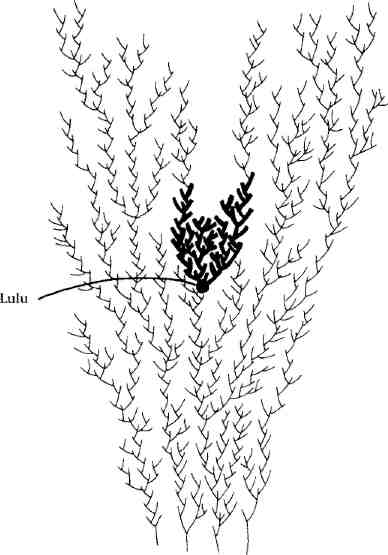Darwin's Dangerous Idea (16 page)
Read Darwin's Dangerous Idea Online
Authors: Daniel C. Dennett

What is the overall shape of this huge Tree of Life spreading its branches through 35 billion years? What would it look like if we could see it all at once from a God's-eye view, with all of time spread out before us in a spatial dimension? The usual practice in scientific graphing is to plot time on the horizontal axis, with
earlier
to the left and
later
to the right, but evolutionary diagrams have always been the exception, usually plotting time on the vertical dimension. Even more curiously, we have accustomed ourselves
to
two opposite conventions for labeling the vertical dimension, and with these conventions have come their associated metaphors. We can put
ear-


88 THE TREE OF LIFE
How Should We Visualize the Tree of Life?
89
gradually lose Design? Is there a possible world in which bacteria are the?
time—we would see billions upon billions of individual unicellular organ-descendants of mammals and not vice versa? These questions about possi-isms, a fraction of which would have trails leading to progeny slightly higher bility will be easier to answer if we first look a bit more closely at what has up the trunk. (In those early days, reproduction was by budding or fission; actually happened on our planet. So let us be clear that for the time being, the somewhat later, a kind of unicellular sex evolved, but pollen-wafting and vertical dimension in the diagrams below stands for time, and time alone, egg-laying and the other phenomena of our kind of sexual reproduction have with
early
at the bottom and
late
at the top. Following standard practice, the to wait for the multicellular revolution in the fronds.) There would be some left-right dimension is taken as a sort of single-plane summary of diversity.
diversity, and some revision of design over time, so perhaps the whole trunk Each individual organism has to have its time line, distinct from all others, should be shown leaning left or right, or spreading more than I have shown.
so, even if two organisms are exact atom-for-atom duplicates of each other, Is it just our ignorance that prevents us from differentiating this "trunk" of they will have to appear side by side at best. How we line them all up, unicellular varieties into salient streams? Perhaps it should be shown with however, can be according to some measure or family of measures of various dead-end branches large enough to be visible, as in figure 4.2, difference in individual body shape—
morphology,
to use the technical term.
marking various hundred-million-year experiments in alternative unicellular So, to return to our question, what would the overall shape of the entire design that eventually all ended in extinction.
Tree of Life look like, if we could take it all in at a glance? Wouldn't it look rather like a palm tree, as in figure 4.1?
This is the first of many trees, or
dendrograms,
we will consider, and of course the limited resolution of the ink on the page blurs quadrillions of separate lines together. I have left the "root" of the tree deliberately fuzzy and indistinct for the time being. We are still exploring the middle, saving the ultimate beginnings for a later chapter. If we were to zoom in on the trunk of this tree and look at any cross-section of it—an "instant" in EARTH FORMED --------------------------------------------------------------------
FIGURE 4.3
There must have been billions of failed design experiments, but perhaps none ever became very distant departures from a single unicellular norm. In any event, if we were to zoom way in on the trunk, we would see a luxuriant growth of short-lived alternatives, as in figure 4.3, all but invisible against the norm of conservative replication. How can we be sure of this? Because, as
we shall see, the odds are heavily against any mutation's being more viable than the theme on which it is a variation.

90 THE TREE OF LIFE
Color-coding a Species on the Tree
91
Until sexual reproduction is invented, almost all the branches we observe, also contain mitochondria, and these always come from one parent only, the at any zoom level, diverge. The exceptions are remarkable, however. At the female. (If you are a male, all the mitochondria in your cells are in an time of the eukaryotic revolution, if we look in just the right place, we will evolutionary cul-de-sac; they will not get passed on to any offspring of yours, see a bacterium entering the rudimentary body of some other prokaryote to who will get all their mitochondria from their mother.) Now step back a pace create the first eukaryote. Its progeny all have a dual inheritance—they from our close-up of matings-with-offspring and notice (in figure
4.4)
that contain two entirely independent DNA sequences, one for the host cell and
most
of those offspring's trajectories terminate without mating, or at least another for the "parasite," sharing its fate with its host's, and linking the fate without offspring of their own. This is the Malthusian crunch. Everywhere of all its descendants (now on their way to becoming benign resident we look, the branches and twigs are covered with the short, terminal fuzz of mitochondria) to the fate of the cells they will inhabit, the descendants of the birth-death without further issue.
cell first invaded. It's an amazing feature of the microscopic geometry of the It would be impossible to see at one time all the branch points and Tree of Life: whole lineages of mitochondria, tiny living things in their own junctions in the whole Tree of Life, extending over 3.5 billion years, but if right, with their own DNA, living their entire lives within the walls of the we backed way off from the details and looked for some large-scale shapes, cells of larger organisms that compose other lineages. In principle it only has we could recognize a few familiar landmarks. Early in the multicellular fan-to have happened once, but we may suppose that many experiments in such out that began about 700 million years ago, we could see the forks that radical symbiosis occurred (Margulis 1981; for accessible summaries, see created two large branches—the kingdoms of plants and animals—and an-Margulis and Sagan 1986, 1987).
other for the fungi, departing from the trunk of the single-celled organisms.
Once sexual reproduction becomes established many millions of years And if we looked closely, we would see that, once they become separated by later, up in the fronds of our Tree (and sex has apparently evolved many some distance, no matings reunite any of the trajectories of their individual times, though there is disagreement on this score ), if we zoom in and look members. By this time, the groups had become reproductively isolated, and closely at the trajectories of individual organisms, we find a different sort of the gap grew wider and wider.1 Further forks created the multicellular phyla, juncture between individuals—matings—with starbursts of offspring result-orders, classes, families, genera, and species.
ing. Zooming in and "looking through the microscope," we can see in figure 4.4 that, unlike the coming together that created eukaryotes, in which both DNA sequences are preserved whole and kept distinct within the bodies of 2. COLOR-CODING A SPECIES ON THE TREE
the progeny, in sexual matings each offspring gets its own unique DNA sequence, knit together by a process that draws 50 percent from one parent's What does a
species
look like in this Tree? Since the questions of what a DNA and 50 percent from the other's. Of course each offspring's cells species is, and how a species starts, continue to generate controversy, we can take advantage of the God's-eye perspective we have temporarily adopted to look closely at the whole Tree of Life and see what would happen if we tried to color-code a single species in it. One thing can be sure: whatever region we color in will be a single, connected region. No separated blobs of organisms, no matter how similar in appearance or morphology, could count as composed of members of a
single
species, which must be united by descent. The next point to make is that until sexual reproduction arrives on the scene, the hallmark of reproductive isolation can have no bearing at all.
This handy boundary-making condition has no definition in the asexual world. In those ancient and contemporary strands in the Tree 1. There have been some remarkable symbiotic reunions, however, of organisms that belong to different kingdoms. The flatworm
Convoluta roscoffensis
has no mouth and never needs to eat, since it is filled with algae that photosynthesize its nourishment FIGURE 4.4
(Margulis and Sagan 1986)!

92 THE TREE OF LIFE
Color-coding a Species on the Tree
93
that reproduce asexually, groupings of one sort or another may interest us for various good reasons—groupings of shared morphology or behavior or of genetic similarity, for instance—and we might choose to call the resulting group a species, but there may very well be no theoretically important sharp edges that would delimit such a species. So let us concentrate on sexually reproducing species, all of which are to be found up in the multicellular fronds of the Tree. How might we go about coloring all the life-lines of a single such species red? We could start by looking at individuals at random until we found one with lots of descendants. Call her Lulu, and color her red.
(Red is represented by the thick lines in figure 4.5.) Now move stepwise up the Tree, coloring all Lulu's descendants red; these will all be members of one species
unless we
find our red ink spreading into two distinct higher branches, none of whose members form junctions across the void. If that happens, we know there has been speciation, and we will have to back up and make several decisions. We must first choose whether to keep one of the branches red (the "parent" species continues red and the other branch is considered the new daughter species ) or to stop the red ink altogether as soon as the branching happens (the "parent" species has gone extinct, fissioning into two daughter species).
If the organisms in the branch on the left are all pretty much the same in appearance, equipment, and habits as Lulu's contemporaries, while the organisms in the right branch almost all sport novel horns, or webbed feet, or stripes, then it is pretty obvious that we should label the left branch as the continuing, parent species, and the right branch the new offshoot. If both branches soon show major changes, our color-coding decision is not so FIGURE 4.5